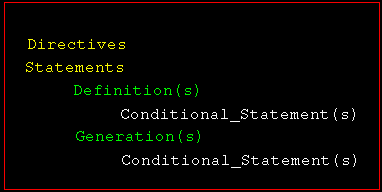Dbgl
Script Structure
A Dbgl script consists of two parts:
Directive Section
This is the section in which you define the environment, the databases that you are going to use, optionally an alias to use as a database name, standard input and output devices and command equivalents. This part of the script is not actually executed, but is used to define the scenario in which the script is going to work.
Statements Section
The statements section consists of one or more definitions and/or generations groups which in turn consist of one or more conditional statements. The Dbgl interpreter cyclically executes each statement group sequentially (in some complex scripts it is possible that one group can pass the control to another group before its end).
Either section may contain comment lines, which are specified by beginning the line with the "!" character.
The tree below outlines the general structure of a Dbgl script:

Figure 1: General Dbgl Script Structure

